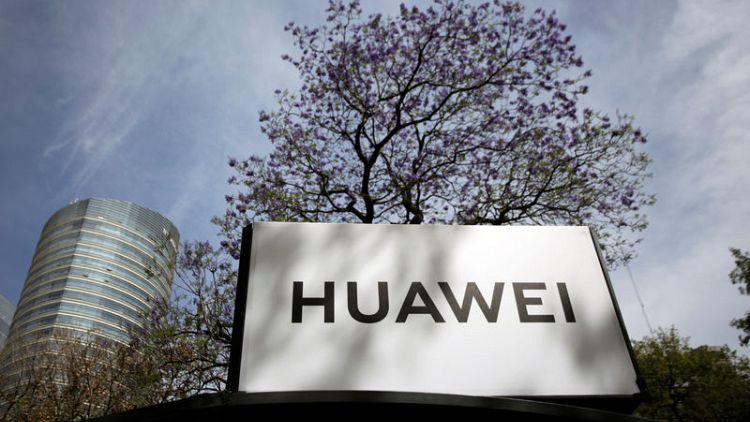By Julia Love
MEXICO CITY (Reuters) - After a long push in Mexico, China's Huawei landed a coveted job in 2017: supplying equipment for the country's so-called "red compartida," an ambitious telecommunications network built for carriers delivering the latest generation of technology.
The contract came with a catch.
Altan Redes, the company developing the network, announced that the most delicate work – involving the system's "core" and sites near the U.S. border – would go to Nokia, and awarded Huawei southern and central Mexico. Political sensitivities around Huawei, which the United States has denounced since 2012 as an untrustworthy agent of the Chinese government, factored into the decision, according to two people with knowledge of the matter.
But limiting Huawei Technologies Co Ltd's role was easier said than done. While sites along the U.S. border remain with Nokia, Huawei has since gained work in three cities in northern Mexican regions that Altan had said publicly would go to Nokia, according to four other people with knowledge of the matter and messages viewed by Reuters. Huawei began working in the cities late last year, one of the people said.
The three cities - Tampico, Torreon and Culiacan – are located in northern Mexico but are not close the border. Altan's plans for the network are fluid and could change, the sources noted.
Altan said in a statement that its decision to divide the work between Nokia and Huawei in that way was made "exclusively on technical and economic optimization criteria," adding that it was not informed of U.S. concerns about Huawei. The company said no cities awarded to vendors were reassigned, and Huawei and Nokia "equally delivered their plans."
A U.S. State Department official said the department remains concerned that Chinese equipment in 5G networks could give the Chinese government access to sensitive data. A Huawei spokesman described the U.S. campaign as an effort to "attack and contain Huawei, without presenting any concrete evidence."
Huawei's northward expansion in Altan's network, previously unreported, underscores the Chinese firm's combination of speed, manpower and technological sophistication, Mexican telecom executives say.
"It's too late" to reverse Huawei's strong presence in Mexico, said Marco Galvan, a senior director for trade group GSMA.
Huawei's potent appeal also shows how telecom operators globally are trying to balance the need for the Chinese company's affordable and reliable equipment with the U.S. campaign to steer countries away from using its gear, Mexican telecom executives say.
After acquiring two local wireless companies, AT&T removed Huawei equipment from sensitive parts of its Mexican network. But AT&T still uses the Chinese firm’s gear in the country, according to two people with knowledge of the matter. That is due in part to Huawei’s deep bench and swift execution, the people said.
“When we upgraded our Mexico network to 4G LTE, we replaced Huawei in our data core network because we wanted a data core network design like we have in the United States,” AT&T Mexico said in a statement.
The approaches taken by Altan and AT&T, detailed in interviews with two dozen people familiar with Huawei's operations, point to new ground rules for working with the Chinese company in Mexico: Limit use of Huawei gear in "the core" - the brains of the cellular network that processes data from towers - and tread carefully along the border.
But some telecom experts say it is harder to wall off the core in the coming fifth generation, or 5G, networks.
In its statement, Altan said the nearest Huawei cell site equipment is 1,549 km from the border town of Tijuana and 499 km from Matamoros, which neighbors Texas.
"The equipment disperses a signal with a radius of 15 kilometres, so there is not even remotely close contact with the northern border," Altan said.
Three people familiar with the decision said Altan gave the northern cities to Huawei following some problems with Nokia's performance, including delays submitting documentation and slow response times.
Dimitri Diliani, Nokia's global head of end-to-end solutions, said in an interview that the company met all key objectives and its share of the Altan project has not changed.
"You always have hiccups and delays," he said. "At the end of the day, we passed all of the hurdles."
Specific cities were not assigned in the contract, Diliani said. It is not unusual for some cities to shift within large projects, a Nokia spokeswoman added.
Cesar Funes, a Huawei vice president, said Mexican customers have asked the company for its response to the U.S. allegations, but business remains strong. He said he was not aware of whether Huawei had won work in the three cities but noted the company has managed to extend its reach in past projects.
Vendors typically start with a certain share of a project, "but based on your performance, you could get more," he said in an interview. "I have experienced that already in this country."
The U.S. government has intensified its fight against Huawei as countries prepare to deploy 5G networks, which will serve as the gateway to new technological frontiers such as self-driving cars and internet-connected appliances. Altan’s wholesale network, which offers capacity to retail telecom competitors in Mexico, is prepared to quickly transition to 5G, the company has said.
TENSION AT THE BORDER
As early as the 1990s, Huawei executives began pitching their services in Mexico. Competing aggressively on price and recruiting talent, Huawei eventually won big swaths of the market, supplying virtually all major players, including Mexican billionaire Carlos Slim's America Movil.
The wholesale network, part of a 2013-14 telecom reform aimed at promoting competition, was an enticing opportunity for Huawei to build a cutting-edge network from scratch, Funes said.
Backed by a fund managed by Morgan Stanley Infrastructure and IFC Asset Management Company’s China-Mexico Fund, Altan won a tender to launch the network in 2016.
The prospect of Chinese participation in a sophisticated national telecom network attracted U.S. scrutiny early on. The U.S. State Department met with Mexico's ministry for communications and transportation twice in 2016 to voice concerns about Huawei's potential involvement in the project, according to a former senior U.S. State Department official.
The State Department did not ask Mexico to ban Huawei, but it did warn Mexican officials of security risks posed by the Chinese firm, the former official said.
Some Mexican officials questioned why the United States was so concerned since AT&T was working with Huawei in the country, the former official recalled.
Salma Jalife, Mexico's undersecretary for communications and technological development, declined to comment.
The State Department also met with Mexico's Federal Telecommunications Institute (IFT), which regulates the industry, in late 2016 to discuss concerns regarding Huawei's potential participation in the network, especially along the border, according to a Mexican official.
A U.S. State Department official said the government works closely with Mexico and declined to comment on specific meetings.
An IFT spokeswoman declined to comment. The Huawei spokesman stressed the company's independence from the Chinese government.
Altan ultimately struck its compromise, tapping both Huawei and Nokia.
"The balance of the allocation of infrastructure between the technological providers is optimal, avoiding an exclusive dependence on either one," Altan said in a statement.
Most carriers in Mexico are still sold on Huawei, said Galvan of GSMA.
"(Huawei) brought as many resources as necessary to Mexico from China," he said. "They did what it takes."
(Reporting by Julia Love; additional reporting by Tarmo Virki and Lesley Wroughton; Editing by Jonathan Weber and Edward Tobin)



